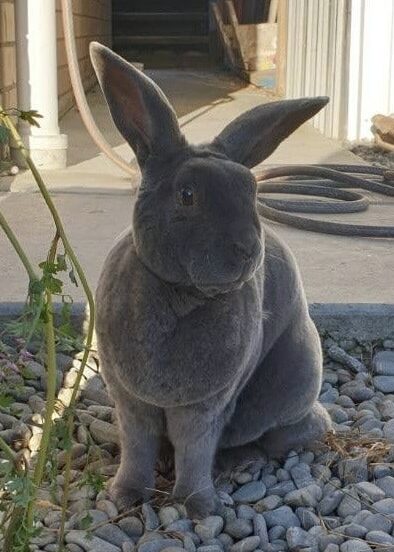I am very fortunate with my pets. I have two beautiful cats who love affection when I’m home, yet are perfectly happy if I’m not. I also have many rabbits! A variety of colours and sizes. I’m not sure how many males or females but they keep multiplying…My rabbits are free range and we admire them in all parts of our garden. The only downside is that we have to fence off all new plants as they love munching on them! Being that we are quite diligent in doing this, and our neighbours aren’t, they pop next door to satisfy this part of their diet when grass supply is low. Obviously we have a wee bit of land and our bunnies aren’t trained, tame or up for pats, but we still enjoy them free ranging in our garden.
Rabbits make great pets, they’re very trainable and can adapt well to being handled, patted, being indoors and having friends. They can have very fun personalities. There are some great books and information around to help with this. However, when considering their care, diet and well-being, keep in mind the free range, self-care bunnies in our garden.
 Diet
Diet
This is the most important thing in caring for your bunny. It links a rabbit’s mental and physical health. The staple diet of a wild bunny is grass, more grass and weeds (with fresh new plant growth on the side.) The rabbit’s digestive system needs grass. Grass and hay supply them with long fibres, which are essential to keep their gut functioning correctly. Because grass is low in calories, they need to eat a lot of it to get the energy that they need to grow and thrive. This means that their digestive system is constantly busy. Their teeth are constantly chewing and they don’t have time to do much else except eat, sleep and breed.
Pet bunnies have the same functional needs. If their digestive system isn’t kept busy, it can become static and cause stress, shock and severe illness (sometimes even death.) The teeth are constantly growing, so if they have long periods without eating, this can lead to overgrown teeth with sharp spurs, causing trauma and pain. If rabbits aren’t kept busy with eating then they look for other things to do eg. chew wires, toys, cages, dig holes, or chase cats!
How do we mimic the wild bunny diet?
- 95% good quality hay and fresh grass. It’s okay to pick grass if you don’t have enough lawn.
- A maximum of 2 teaspoons of pellets or dry food per day. Formulated dry diets are high in protein and energy. Too much of this will mean your bunny quickly and easily satisfies it’s daily calorie requirement and no longer needs to eat the grass, hay or weeds. As mentioned above, a rabbit that doesn’t continuously eat is prone to digestive, teeth and behavioural issues.
- As a treat, a small amount of fresh fruit or vegetables 2 to 3 times per week.
On top of this as much stimulation, games and contact time as you like. They will love it !!
Pellets
Several rabbit pellet varieties are available. Find one where all the pellets look the same rather than a “muesli” appearance. You’ll find if rabbits are fed a “muesli” type, that they will pick out all the sweet treats they like the best. These can be high in sugar which is detrimental to their teeth and digestive system.
Vaccination
In addition to diet we can look after pet bunnies further by vaccinating them for Calici virus. This will sadly be keeping our free range bunny population down. It is also known as viral haemorrhagic disease (VHD) and will usually cause sudden death.
Female rabbits are very prone to uterine cancer and spaying them can prevent this, adding further years to their life.
Dr Kim Green and The Halifax Team

 Diet
Diet
Recent Comments